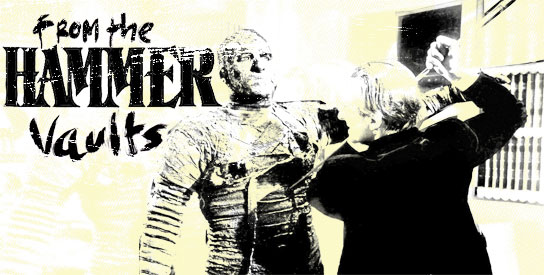 When you think of Hammer Film Productions, things that may spring to mind are Dracula or Frankenstein. You think of Christopher Lee, Peter Cushing and Michael Ripper. Images of decadent locations, lavish costumes and tasteful stories appear. You might even be reminded of the cheese of productions like One Million Years B.C. (1966) or the sleaziness of their later vampire movies. One movie that probably doesn’t instantly associate itself with the memory of Hammer is Terence Fisher’s The Stranglers of Bombay. This obnoxious, violent and thoroughly entertaining movie does not contain the typical elements of a Hammer production. But, as offensive as it is, The Stranglers of Bombay is – even though I’m sure the studio would like to deny it – a Hammer film. In the same league of politically incorrect Hammer flicks like The Camp on Blood Island (1958), The Stranglers of Bombay is a fascinating piece of utterly jaw-dropping Hammer history.
When you think of Hammer Film Productions, things that may spring to mind are Dracula or Frankenstein. You think of Christopher Lee, Peter Cushing and Michael Ripper. Images of decadent locations, lavish costumes and tasteful stories appear. You might even be reminded of the cheese of productions like One Million Years B.C. (1966) or the sleaziness of their later vampire movies. One movie that probably doesn’t instantly associate itself with the memory of Hammer is Terence Fisher’s The Stranglers of Bombay. This obnoxious, violent and thoroughly entertaining movie does not contain the typical elements of a Hammer production. But, as offensive as it is, The Stranglers of Bombay is – even though I’m sure the studio would like to deny it – a Hammer film. In the same league of politically incorrect Hammer flicks like The Camp on Blood Island (1958), The Stranglers of Bombay is a fascinating piece of utterly jaw-dropping Hammer history.
THE STRANGLERS OF BOMBAY
1959, Terence Fisher

Guy Rolfe plays Captain Harry Lewis, a British officer held in low esteem because of his rapport with the Indian population, and his concern over a wave of mysterious disappearances. The East India Tea Company hold the franchise on both commerce and civil administration for the whole of the Indian district. All they care about is keeping the caravans moving, and Lewis’s pleas to investigate the mass disappearances fall on deaf ears.
What Captain Lewis’s superiors don’t know is that a secret cult of Kali-worshipping stranglers – the Thuggees – has been looting the country for centuries, murdering perhaps millions of people over that time. The Thuggees are trained to infiltrate rich caravans, strangle everyone and bury the bodies. Like an evil Mohandas Gandhi, the Thuggee High Priest (George Pastell) incites his followers’ bloodlust and brainwashes them into a mortal terror of betraying the cult.
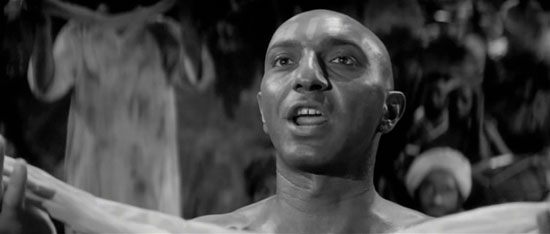
The leader of the "strangling cult"
The Stranglers of Bombay may be somewhat based in fact, but that doesn’t stop it from being one hell of an exploitative film. Made in 1959 and with its politically and racially volatile setting, it would be difficult for it to not at least be a little offensive. I found it hard to judge exactly how racist The Stranglers of Bombay is. Sure, there are white actors in brown face thrown amongst the true Indians and the mixture of accents is careless, but this is not out of the norm in a film from the 50s. The racism in The Stranglers of Bombay is inconsistent and somewhat confusing. The film’s protagonist – the white Captain Harry Lewis (Guy Rolfe – clearly filling in for Peter Cushing) – seems to love India and wants to save the locals from slaughter from the “strangling cult”. But for every time he says something positive like “Indians never desert their families”, he’ll refer to an Indian as “boy” or aggressively interrogate a shop keeper asking “are you not interested in what happens to your kind?” Every Indian character is either weak and needs the British helping hand or a murdering member of the Thuggee cult. While I don’t believe it was entirely deliberate, there is a underlying message that without Britain, India is screwed. At the same time, the British – other than our hero – aren’t shown in a good light either. The British in The Stranglers of Bombay are pompous and put business over human life.
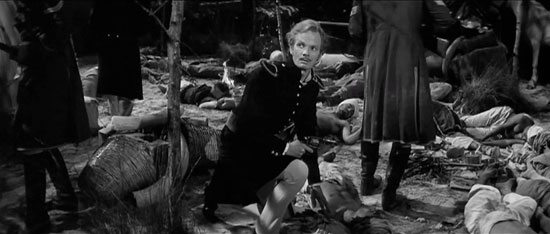
A pompous Brit surrounded by freshly strangled corpses
It’s not the racism – I’ve seen far, far worse – in The Stranglers of Bombay that makes it the crass film that it is. It’s the violence – or, to be precise, the cruelty of the violence. There are gorier Hammer films than The Stranglers of Bombay, but none quite as brutal. The film starts innocently enough with the Thuggee cult – those that have seen Indiana Jones and the Temple of Doom (1984) will see where Spielberg drew his influence from – in the middle of a ceremony where a cult member has his arm sliced and burnt with a branding iron. It’s nothing particularly alarming and certainly does not prepare us for the carnage to come. The first moment of shocking cruelty comes when two Thuggees have their eyes burnt out and tongues removed for allowing “sacred silk to fall into the hands of an unbeliever”. (The silk, by the way, is for strangling.) The scene is horrific, without showing much onscreen violence. Fisher cuts way before the iron penetrates the first man’s eye, we cut to Patel Shari (Marne Maitland), the man who condemned them to their punishment, listening to their screams and shivering. Shari then returns to see the men moaning and crawling on the ground, blood pouring from their empty eye sockets and mouths.
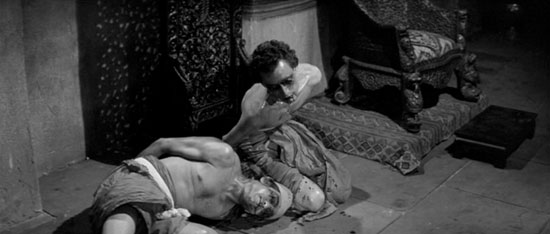
It's a tough life for Thuggees
The torture doesn’t end there for these poor characters. In what is the film’s most disturbing scene, the now eyeless and tongueless ex-Thuggees are placed in a cage where a female Thuggee (Marie Devereaux) tosses them scraps of food and water. They scramble for the food, scoffing it down on their hands and knees like animals, the woman disturbingly smiles as she watches them suffer. The Stranglers of Bombay is still censored even to this day. The original cut omits a few more moments where Marie Devereaux smiles and laughs at the torture and death of prisoners. But the censors allowed one more moment of intense cruelty from Devereaux to remain intact. In a scene where our hero is tied to rocky ground in the terrible heat, Devereaux watches him, amused, while she happily drinks water. It’s a simple, but disturbing, act of evil.
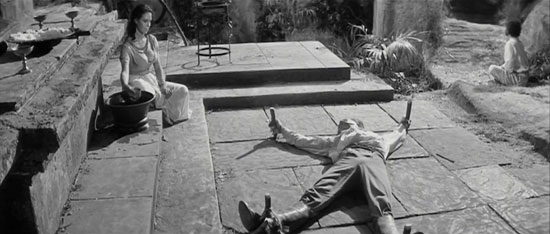
Devereaux in one of many evil moments
The scene where Captain Lewis is taunted by Devereaux continues down a creatively cruel path. The Thuggee leader (The Mummy‘s George Pastell) slices open Lewis’s leg and lets a cobra loose to finish him off. The act is interrupted by a mongoose, and we then endure an obviously real fight between the mongoose and snake. The Thuggees engage in many more moments of shocking barbarity. A man is forced to strangle his own brother, an entire caravan of travelers are murdered, a gory severed hand is tossed through a window as a warning to Lewis and his wife and thirty corpses with broken necks are uncovered and revealed as victims of the Thuggees. A particular standout of madness is where a brainwashed Thuggee, arrested by the British, gleefully throws himself into the noose at a public hanging. But it is not only the Thuggees that provide the shocks, the British also engage in a few acts of nastiness. During interrogation, a British officer forces an old Indian man to close his eyes and walk around a room blindfolded to prove an obscure point. It’s quite an unpleasant moment.

The mongoose uncovers a gravesite
An obnoxious and politically incorrect movie indeed, The Stranglers of Bombay is nonetheless entertaining. Just like Temple of Doom, it is an adventure movie with moments of surprising brutality. And those adventure elements make for an oddly enjoyable viewing. The sets and locations are fantastic and Fisher captures them with beautiful black and white photography. Early on, Fisher shows us the village where the majority of the film is set in with a series of excellent tracking shots. It’s obvious from this point that, despite its low budget, The Stranglers of Bombay is a technically well-made movie. Its visual slickness combined with its gritty storytelling make for an absurd and exciting blend. The Stranglers of Bombay won’t please everyone and – even today – it will offend some, but it is a bizarrely captivating slice of Hammer history. The Stranglers of Bombay is available as part of the awesome Icons of Adventure DVD set, which also includes the equally lurid The Terror of the Tongs.




